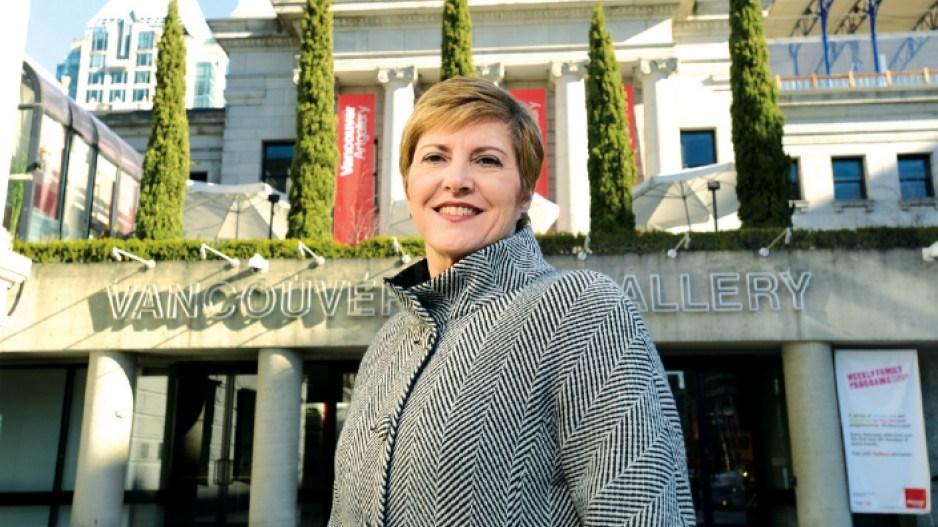Vancouver Art Gallery (VAG) officials have yet to start raising funds for a new $300 million, 310,000-square-foot facility, but they already have approximately $93.7 million in contributions and pledges.
VAG director Kathleen Bartels plans to present her case later this month to Vancouver city council in an effort to get the city to either donate or agree to an extremely cheap lease agreement so VAG can use two of the three acres in the city block bounded by West Georgia, Cambie, Dunsmuir and Beatty streets – a block known as Larwill Park.
If the city donates the site, it will essentially be giving VAG the equivalent of a $200 million donation, said realtor and former VAG director Bob Rennie. That would be the cost of the land, taxes and foregone community amenity contributions, added Rennie, who wants the gallery to consider building several smaller sites.
Bartels is confident that if the city donates the land, VAG will be able to raise the remaining $206 million needed to build the facility. “The province gave $50 million, and we’ve had interest accumulate on that,” Bartels said. “We’ve also had other individuals step forward to add to that fund. Then there are nearly $40 million in private pledges that are based on site confirmation.”
The gallery had $53.7 million in its capital fund for the new building at the end of June 2012. All pledges are verbal and non-binding, although Bartels said they’re reliable in part because they were made in the past two years.
VAG’s business plan is silent on how it will raise the remaining capital needed to build its desired new building. The plan instead focuses on how the gallery will break even operationally.
“Our plan projects that the new gallery will be operationally sustainable,” Bartels said. “That comes from attendance, membership and fundraising. These projections are based on not having any increased government funding on the operational side. It’s maintaining our government support as it is currently.”
However, VAG will lobby the federal government for a contribution to its building fund and for operational support.
Bartels said VAG generates about 40% of its revenue from “earned” sources such as memberships, visitation and retail sales. That’s more than the average of 36% for most museums, she said.
“Look at Toronto or even Winnipeg and the amount of federal support that’s there,” she said. “Certainly Ottawa, but also in projects from Edmonton to Banff, 80% of the projects are funded by government. I’m not suggesting that [VAG should get 80% of its funding from governments], but VAG now raises more than 75% of its operational money either from private individuals and corporations or through earned revenue.”
Operational savings would also accrue were VAG to locate at a single large facility, Bartels said, because it could consolidate square footage for loading bays, visitor services areas and cafés. She added that security costs could also be streamlined.
The pros and cons of multiple gallery sites
Opponents of the Vancouver Art Gallery’s proposal to build a $300 million new facility at Larwill Park argue that it will cost half that amount to build a Vancouver Art Gallery System – seven smaller, niche galleries to be incrementally built during the next 15 years.
The $150 million in savings, they say, could be invested in the art.
“What I find humorous is that a lot of the artists are fighting for the building, and I’m fighting for the content,” said Bob Rennie, who owns Rennie Marketing Systems and has a substantial art collection.
Rennie pointed to many examples of art galleries around the world that operate multiple sites, including:
•Seattle Art Museum (three sites);
•Staatliche Kunstsammlungen Dresden (a 12-museum alliance in Germany); and
•Honolulu Museum of Art (five venues).
Many of Rennie’s examples tend to have evolved over time, however, and were not intended at conception to have multiple sites.
“[Having multiple sites] is working but it’s an incredible headache,” Honolulu Museum of Art director Stephan Jost told Business in Vancouver.
“If I had a magic wand, I would want it all in one geographic area. We make it work but it’s not easy.”
Added Vancouver Art Gallery director Kathleen Bartels: “At VAG, we don’t segregate artists by nationality or ethnicity. So, we don’t have a First Nations gallery or an Asian gallery. We think it’s very important that those artists are shown together.”




